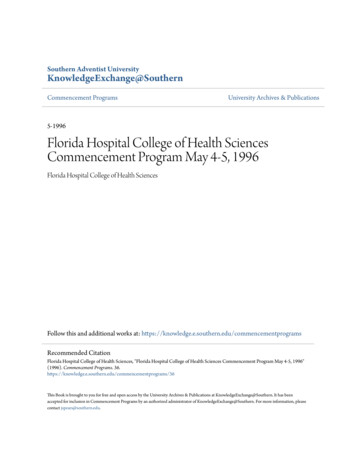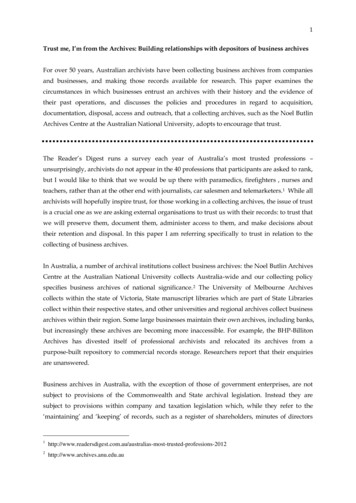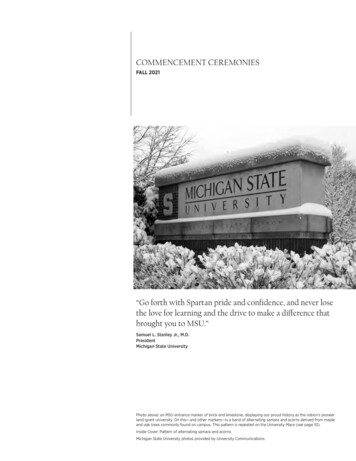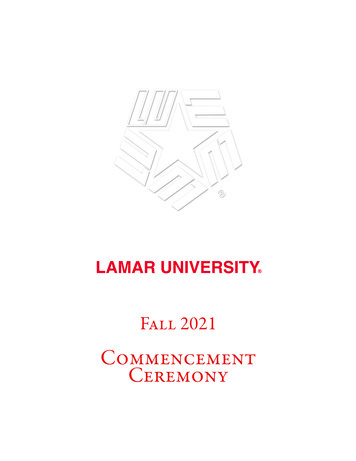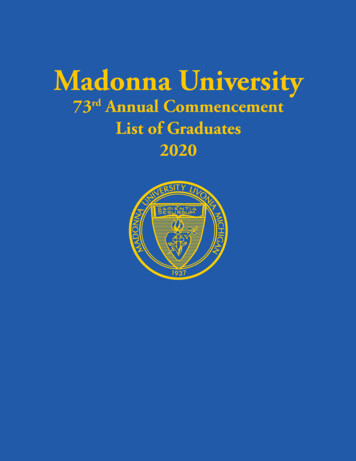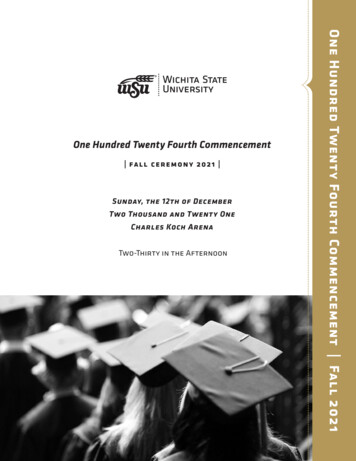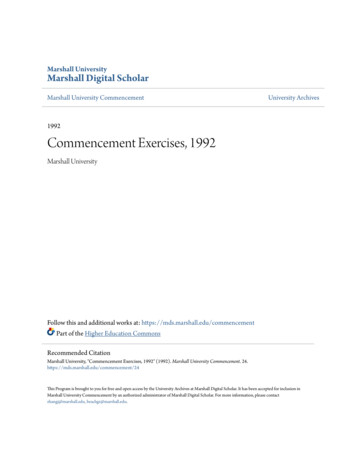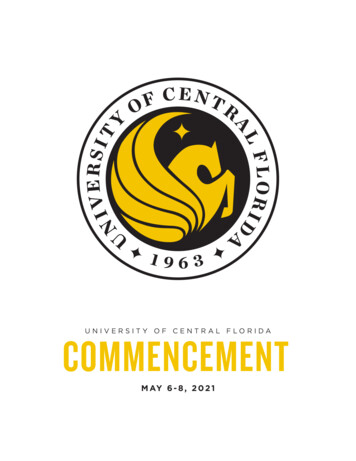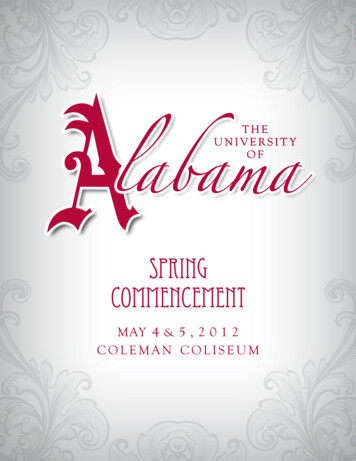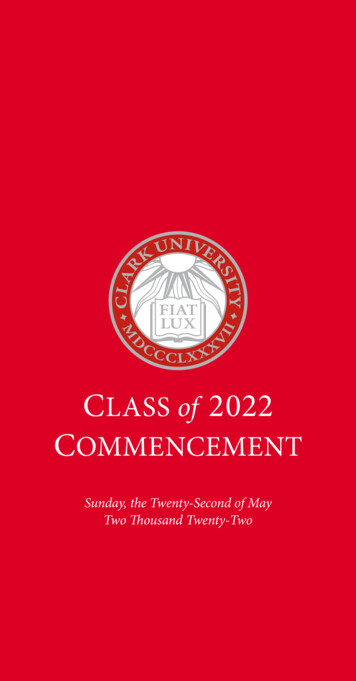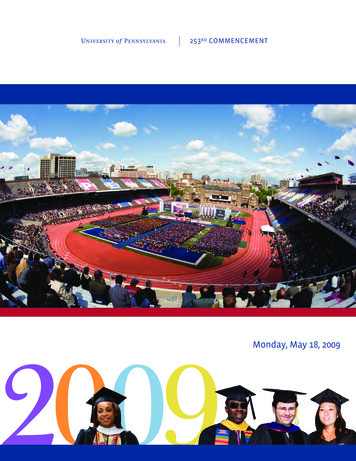
Transcription
253 RD COMMENCEMENT2009Monday, May 18, 2009
The University of PennsylvaniaKEEPING FRANKLIN’S PROMISEIn the words of one elegiac tribute, “Great men have two lives: one which occurs while they work on this earth;a second which begins at the day of their death and continues as long as their ideas and conceptions remain powerful.”These words befit the great Benjamin Franklin, whose inventions, innovations, ideas, writings, and public works continue toshape our thinking and renew the Republic he helped to create and the institutions he founded, including the University ofPennsylvania.Nowhere does Franklin feel more contemporary, more revolutionary, and more alive than at the University of Pennsylvania.His startling vision of a secular, nonsectarian Academy that would foster an “Inclination join’d with an Ability to serveMankind, one’s Country, Friends and Family” has never ceased to challenge Penn to redefine the scope and mission of themodern American university.When pursued vigorously and simultaneously, the two missions – developing the inclination to do good and the ability to dowell – merge to help form a more perfect university that educates more capable citizens for our democracy.Penn has embodied and advanced Franklin’s revolutionary vision for 269 years. Throughout its history, Penn has extendedthe frontiers of higher learning and research to produce graduates and scholars whose work has enriched the nation and all ofhumanity.The modern liberal arts curriculum as we know it can trace its roots to Franklin’s innovation to have Penn students studyinternational commerce and foreign languages.The first medical and business schools in the United States were launched here.And the first general-purpose electronic, digital computer – ENIAC – was invented right here at the University of Pennsylvania.At Penn, the never-ending quest for innovation and academic distinction has found perfect Franklinian expressionin “The Penn Compact,” President Amy Gutmann’s bold vision for propelling our University from excellence to eminencein all our core endeavors. Fulfilling the goals of the Compact – increasing access for talented students of all backgrounds,integrating knowledge across multiple disciplines, and engaging our knowledge with communities locally and globally – is thefocus of Penn’s current 3.5 billion Making History campaign, and will position the University to make the greatest possiblecontribution to our society and our world.Today, Penn proudly graduates a class of men and women who have shown the intelligence, drive, integrity, andcharacter to become engaged citizens who will serve humanity with distinction. Our Penn graduates are poised to take theirplace as productive democratic citizens and as just and humane stewards of our world.In these challenging and perilous times, a world in need of young men and women who are willing to shoulder the moralresponsibilities of leadership can look to Penn.Franklin wrote: “We may make these times better if we bestir ourselves. The noblest question in the world is ‘What good may Ido in it?’”The answer to this question will be furnished by Franklin’s newest heirs, the graduates of 2009.1
Franklin FieldCOMMENCEMENT SEATINGGuests will find this diagram helpful in locating the approximate seating of the degree candidates.The sequence in which the candidates are presented for degrees is shown on the next page.The list on page 13, detailing the colors of the candidates’ hoods according to their fields of study,may further assist guests in identifying the locations of the various schools.In case of emergency, evacuation procedures will be announced.GUESTENTRYfrom33rd St.COMMENCEMENT STAGEGUESTENTRYfromSouth St.SOUTHSTANDSguest seatingNORTHSTANDSguest seatingEASTSTANDSguest seating2
ContentsKeeping Franklin’s Promise. 1Franklin Field Commencement Seating. 2The Commencement Ceremony. 4Historical Notes. 6Academic Ceremony and Regalia. 12The Schools of the University. 14Honorary Degree Citations. 16Degrees in Course. 18The School of Arts and Sciences. 18The College of Arts and Sciences. 18The Graduate Division. 26The College of Liberal and Professional Studies. 26The School of Engineering and Applied Science. 29The Wharton School. 33The Wharton Undergraduate Division. 33The Wharton Graduate Division. 36The School of Nursing. 41The School of Medicine. 43The Law School. 45The School of Design. 47The School of Dental Medicine. 49The School of Veterinary Medicine. 50The Graduate School of Education. 51The School of Social Policy & Practice. 54The Annenberg School for Communication. 55The Graduate Faculties. 56ROTC Commissions. 61Principal Academic Honor Societies. 62Prizes and Awards. 64Faculty Honors. 70Alumni Representatives. 74Commencement Marshals. 75Trustees of the University. 76Officers of the University. 77School Ceremonies. 783
The Commencement CeremonyThe audience is requested to stand during the Academic Procession, the singing of the National Anthem, the Invocation, theDismissal and the singing of “The Red and Blue,” and to remain in place until the Academic Procession has left the field.MUSICWestminster BrassJames W. Hala, DirectorSTUDENT PROCESSIONALUMNI PROCESSIONProcession of the Alumni Class RepresentativesProcession of the Class of 1984Procession of the Class of 1959ACADEMIC PROCESSIONOPENING PROCLAMATIONJames S. Riepe, Chair of the Board of TrusteesTHE NATIONAL ANTHEMDavid J. Doyle, C’09 Oh, say, can you see, by the dawn’s early light,What so proudly we hailed at the twilight’s last gleaming?Whose broad stripes and bright stars, thro’ the perilous fightO’er the ramparts we watched, were so gallantly streaming.And the rockets red glare, the bombs bursting in air,Gave proof through the night that our flag was still there.Oh, say, does that star-spangled banner yet waveO’er the land of the free and the home of the brave?INVOCATIONCharles L. Howard, ChaplainGREETINGSAmy Gutmann, PresidentPresentation of the 25th and 50th Reunion ClassesRemarksACADEMIC HONORSVincent Price, Interim ProvostGREETINGSHarvey Rubin, Chair, Faculty SenateCONFERRAL OF HONORARY DEGREESThe PresidentYvon Chouinard.Doctor of Humane LettersFounder, Patagonia, Inc.Co-founder, One Percent For The PlanetGeorge Crumb, Ph.D.Doctor of MusicPulitzer Prize-winning ComposerWalter H. Annenberg Professor Emeritus in the Humanities, University of Pennsylvania4
THE COMMENCEMENT CEREMONY (CONTINUED)Jennifer Yvonne Mokgoro, Esq. GL’90.Doctor of LawsJudge, Constitutional Court of South AfricaEric E. Schmidt, Ph.D. Doctor of ScienceChairman of the Board and Chief Executive Officer, Google, Inc.Susan Solomon, Ph.D. Doctor of ScienceSenior Scientist, Earth System Research Laboratory, National Oceanic & Atmospheric Administration1999 National Medal of Science RecipientCo-chair of the Intergovernmental Panel on Climate Change, 2002-2008Muhammad Yunus, Ph.D.Doctor of LawsFounder and Managing Director, Grameen BankWith Grameen Bank, recipient of the 2006 Nobel Peace PrizeINTRODUCTION OF THE COMMENCEMENT SPEAKERThe Interim ProvostCOMMENCEMENT ADDRESSEric E. Schmidt, Chairman of the Board and Chief Executive Officer, Google, IncCONFERRAL OF DEGREES IN COURSEThe PresidentCandidates are presented by the Deans and the Associate ProvostCLOSING REMARKSThe PresidentDISMISSALThe ChaplainTHE RED AND BLUEBy William J. Goeckel, Class of 1896, and Harry E. Westervelt, Class of 1898Come all ye loyal classmates now, in hall and campus through,Lift up your hearts and voices for the royal Red and Blue.Fair Harvard has her crimson, old Yale her colors too,But for dear Pennsylvania, we wear the Red and Blue.(Chorus)Hurrah! Hurrah! Pennsylvania!Hurrah for the Red and the Blue;Hurrah! Hurrah! Hurrah! Hurrah!Hurrah for the Red and the Blue.RECESSIONAL5
Historical NotesTWO HUNDRED FIFTY YEARS AGOThe Commencement of 1759To-morrow will be held a PUBLICK COMMENCEMENT, in the Hall of the COLLEGE and ACADEMY of this City,from Ten to Twelve in the Forenoon, and from Three to Five in the Afternoon, at which Time the Company of all that pleaseto attend, will be very acceptable.Pennsylvania Gazette7 June 1759The Vice Provost presented to the Trustees Samuel Powell,Samuel Keene, William Paca, Alexander Lawson, John Hall,John Beard, & William Edmiston, as Candidates for theDegree of Bachelor of Arts, informing them, that they hadfinished their Studies, had undergone a public Examination,and were well qualified; whereupon the Trustees issuedthe written Mandate, under their Hands & the privy Sealof their College, directed to the Provost, Vice Provost andProfessors, requiring them to admit said Students to theDegree of Bachelor of Arts, and likewise they gave a likeMandate to admit the Reverend Mr. Hector Alison, nowon Duty as Chaplain in the Pennsylvania Regiment; and theRevd. Mr. John Ewing, their present Lecturer in NaturalPhilosophy to the honorary Degree of Master of Arts.After which the Trustees repair’d to the Academy Hall,preceded by the Candidates for Degrees, in their Gowns,and the Members of the Faculty in their Gowns, and werefollow’d by the Masters and Tutors of the several Schoolsat the Head of the junior Classes and the Scholars, whowalked in Procession, two by two; and having respectivelytaken their Seats, the Commencement was open’d by Prayer,performed after the Rites of the Church of England by theReverend Mr. Peters, President [of the Trustees].There was a great Variety of entertaining Orations and publicDisputations in the Latin and English Languages, in whichthe Students, acquitting themselves with universal Applause,the said Mr. Alison, who presided, according to Charter, inthe Absence of the Provost, conferred the several Degrees asdirected by the two Mandates.At the Close of this Ceremony, which was perform’d in a verysolemn Manner, the Vice Provost made a serious Address tothe Graduates, exhorting them to fear God, prosecute theirStudies, and make it the whole Endeavor of their Lives tobecome as useful as possible in their respective Stations,and to consider this World as preparative for the Fruitionof a holy God, in that glorious State of Immortality, whichthro’ the Merits of our blessed Savior, was to succeed thistransitory Life, And then concluded with a suitable Prayer.It gave the Trustees a very sensible Pleasure to hear theCommendations that were given of the whole Performancesby almost every Body present.Minutes of the Trustees of the College,Academy and Charitable Schools8 June 1759The honorable the Governor, several Officers of the Army,a great many Gentlemen of this, and the other Colonies & aNumber of Ladies and Citizens were pleas’d to favor us withtheir Presence.250 years ago: Penn held theCommencement of 1759 inits Academy building (1750)(at the left in this view). The18th century campus, locatedat Fourth and Arch Streets,consisted only of the Academybuilding and the Dormitory(1762) (at the right). This sketch,by Pierre Eugène Du Simitière,ca. 1780, is the only survivingcontemporary rendering of theFourth Street campus.Courtesy of the Library Companyof Philadelphia.6
HISTORICAL NOTES (CONTINUED)250 years ago: Samuel Powel (1739-1793) was one of the studentswho graduated at the Commencement of 1759. He later became one ofPhiladelphia’s leading citizens, twiceserving as the City’s mayor and twiceas a Trustee of the Universityof Pennsylvania. SamuelPowel remains well knownin Philadelphia today forthe elegant townhousehe owned at 244 SouthThird Street, which hasbeen preserved and isopen to the public, and asthe founder of PoweltonVillage, located justnorth of the Universityof Pennsylvania in WestPhiladelphia. Oval portraitattributed to AngelicaKauffmann.Courtesy of the University ArtCollection, University of Pennsylvania.Penn was following what it believed to be the best of Old Worldtraditions, borrowed from Oxford and Cambridge and adapted to thecircumstances of American higher education. Commencement wasthe day for celebrating the graduates’ learned achievements and thestudent “orations” and “disputations” commanded no less than a fourhour program. It was also an occasion for recognizing and honoringthe accomplishments of those who had led lives of successful endeavor.The awarding of honorary degrees fulfilled that purpose. Finally, itwas a time for reflection upon and commitment to fundamental valuesin life. The closing address, delivered by the highest ranking officerof the institution, sought to convey to the graduates the significanceof their collective future. The academic robes, the formal procession,the prayers, the grandeur of the building and the audience – all helpedserve to inspire the participants. Commencement was meant to be oneof the most memorable events in one’s life.ONE HUNDRED FIFTY YEARS AGOThe Commencements of 1859Adjourned Special MeetingMarch 17th, 1859, 11½ o’clock A.M.The academic year which concluded in the Commencement of 1759was just the tenth in Penn’s history, but it was surely as astonishingand extraordinary as any year in the 250 since then. The Provost wasthe Rev. William Smith, a priest in the Church of England, but also aregular and strident writer of political essays. In the fall of 1757 he hadprinted a particularly harsh attack on the Pennsylvania state legislature.The legislature, finding him guilty “of promoting and publishing afalse, scandalous, virulent and seditious libel against the late House ofAssembly of this Province,” ordered him imprisoned. Penn’s Trustees,however, took Provost Smith’s side in the controversy and in February1758 directed the undergraduate students to attend Smith’s classes“at the usual Hours in the Place of his present Confinement,” that is,in the county jail! The standoff continued for two months before thelegislature adjourned and the Provost was released. In November,however, when the Assembly re-convened, calls again were madefor Smith’s arrest. This time the Provost asked the Trustees fortheir permission to sail to England with an appeal to the King. TheTrustees granted him that permission and in early December Smith leftPhiladelphia.Provost Smith taught the senior class and the Trustees, anxious tohold Commencement in June, scrambled to find a substitute teacher.It gave them great pleasure when they found a suitable candidate atPrinceton and were able to recruit him in the middle of the academicyear. The new member of the Penn faculty was Rev. John Ewing, aminister in the Presbyterian church and learned in both the liberal artsand the natural sciences. Rev. Ewing took hold of his responsibilitiesimmediately; the undergraduate calendar remained on schedule. Sevenstudents passed their examinations and formed the Class of 1759.The crisis eased (and Smith was successful in his appeal: he returnedto Philadelphia in October with an exoneration from the King’s PrivyCouncil and an honorary doctorate from Oxford!).The Trustees’ minutes of the Commencement of 1759 provideone of the best accounts of an early commencement on record.The descriptive detail given to every step of the process – fromthe “public Examination” of the College seniors, to the grant ofauthority conferring the degrees, to the conduct of the graduationceremony itself – testifies to the importance of the proceedings.The Board met, pursuant to adjournment at the last meeting,to attend the Medical Commencement, and proceeded tothe Musical Fund Hall, where, after prayer by the Rev.Dr. Schaeffer, the degree of Doctor of Medicine was, withthe usual ceremonies, conferred by the Provost upon thefollowing gentlemen, who had been recommended for thedegree by the Medical Faculty.[The minutes then list the names of the 140 graduates, withthe states of their respective residences, and the titles of theirrespective graduating essays.]An address was then delivered to the graduating Class byProfessor Smith.AdjournedMinutes of the Trustees of the University of Pennsylvania17 March 1859150 years ago: MusicalFund Hall, where theUniversity held both itsCommencements of 1859,still stands at the southwestcorner of Eighth and LocustStreets. It is associated withmany world-renowned 19thcentury musicians, but mostfamous for hosting, in 1856,the first national conventionof the Republican Party.This photograph of thefront of the Hall, takensometime in late 19thcentury, shows the buildingas it appeared after its 1847remodeling.Photograph from thepublication Centenary,Musical Fund Society ofPhiladelphia, 1820 – 1920.7
HISTORICAL NOTES (CONTINUED)150 years ago: HenryHollingsworth Smith (18151890), speaker at the MedicalCommencement of 1859, wasProfessor of Surgery in the Schoolof Medicine from 1855 until1871. He was later President ofthe Philadelphia County MedicalSociety and President of the MedicalSociety of the State of Pennsylvania,as well as Chairman of the SurgicalSection of the American MedicalAssociation. Portrait photograph,photographer unknown.Collections of the University Archivesand Records Center, University ofPennsylvania.UNIVERSITY COMMENCEMENTThe Commencement of the Medical Department of theUniversity of Pennsylvania took place at the Musical FundHall at noon yesterday. The hall was packed full in everypart and it was found necessary to close the doors some timebefore the commencement of the exercises. A great numberof persons were unable to obtain admission to the building.The graduates, headed by the officers and faculty, walkedin procession from the University to the hall. The exerciseswere opened with prayer by the Rev. Mr. Schaeffer, afterwhich the degree of Doctor of Medicine was conferred uponthe graduates by Henry Vethake, LL.D., Provost of theUniversity.Henry H. Smith, M.D., Professor of Surgery, delivered thevaledictory. He gave a sketch of the duties of the physician tothe public, and spoke of the high tone which every honorablemedical man should maintain; alluded to the position ofsociety to a physician; to the fact that the physician andphilanthropist must not expect great rewards, but must beactuated by nobler motives; of the evils of quackery; andclosed as follows:“When, in after life, temptations assail you; when evilinfluences beset and assail your fair fame, may you recallthe fact, to-day presented to you in words of kindly interest,that you are members of a noble profession, attached to asociety of honorable men, and that, as such, honor forbidsyour yielding to the temptations of the enemy, and baselydeserting the flag under which you are now enrolled. Wishingyou every happiness, I, in the name of my colleagues, tenderyou our farewell.”Philadelphia Press18 March 1859Penn’s Trustees established the School of Medicine in 1765 andit soon proved to be a profound innovation in American highereducation. By 1800 the School of Medicine had grown larger than theCollege and by 1830 it was generally acknowledged as the premierAmerican institution of medical education. In the 1858-59 academicyear there were 409 students in the School of Medicine, representingtwenty-three states, the District of Columbia, and six foreign countries.The School’s faculty had its own buildings on campus and conductedits internal affairs largely independent of the Provost and the Trustees8of the University. Through most of the 19th century the uniquestatus of the School was well illustrated by its academic calendar –considerably shorter than that of the College – and its stand-aloneannual commencement.The School of Medicine conducted its commencements in a mannermore familiar to us today than did the College. The ceremony’semphasis was not so much the academic attainments of the students –though the conferring of the M.D. degree certainly acknowledged thatachievement. The emphasis was rather on the commencement speakerand the significance of his address for the newly-credentialed graduates.In 1859 Henry Hollingsworth Smith was in just his fifth year on Penn’sfaculty, but he was well known as a surgeon of unusual ability; a prolificscholarly author; and a powerful public speaker. Those qualities ledhis medical faculty colleagues to select him as their representative atcommencement. The Philadelphia newspapers celebrated his addressand called for its publication. His leadership in the medical professionwas perhaps best demonstrated two years later, when, at the outbreakof the Civil War, the Federal government chose him to organize thehospital system of Pennsylvania and the state appointed him SurgeonGeneral of the Commonwealth of Pennsylvania. Smith was the verymodel of the modern commencement speaker.Adjourned MeetingJuly 1, 1859, 9¾ [o’clock] A.M.The Board met pursuant to adjournment to attend theCommencement and proceeded to the Musical FundHall, where the following degrees were, with appropriateceremonies, conferred by the Provost, after prayer by the Rev.C.W. Schaeffer and Orations by Members of the graduatingClass.[The minutes then list the names of thirty graduates of theCollege, the twelve graduates of the Law School, four lategraduates of the School of Medicine, and the twenty-fiverecipients of the semi-honorary degree of Master of Arts.]The Provost announced the names of the gentlemen to whomthe Henry Reed and other Prizes had been awarded and theexercises were concluded by a Valedictory Oration from amember of the Graduating Class.AdjournedMinutes of the Trustees of the University of PennsylvaniaFriday, 1 July 1859150 years ago: Edward BlanchardHodge (1841-1906) delivered the Greeksalutatory at the University Commencementof 1859. Following his graduation fromthe College at Penn, he enrolled in thePrinceton Theological Seminary, fromwhich he graduated in 1863. He wasordained a Presbyterian clergyman, servedfor thirty years as pastor of the PresbyterianChurch of Burlington, New Jersey, and in1893 was named Secretary of the nationalPresbyterian Board of Education. He heldthat position until his death. Photographtaken from the publication University ofPennsylvania (Illustrated).Collections of the University Archives and Records Center, University ofPennsylvania.
HISTORICAL NOTES (CONTINUED)Commencement of the University of PennsylvaniaThe annual commencement of the University of Pennsylvaniawas held yesterday morning, at the Musical Fund Hall,in the presence of a large assemblage. At ten o’clock theprocession, composed of the Professors and GraduatingClass, entered the Hall, the Germania Orchestra performingmeanwhile, one of their choice selections. Though, accordingto the programme, the Orchestra was to perform pieces atdifferent periods of the exercises, there was no music after theintroductory, owing to the serious illness of the Hon. RichardRush, residing in the neighborhood. The opening prayer wasfollowed by the Salutatory Oration in the Greek, by EdwardB. Hodge. This was succeeded by addresses on the subjectnamed “Eldorado,” by Edward P. Capp; “The Battle ofTours,” by Richard A. Coleman; “Historic Rivers,” by JamesB. Roney; “The Balance of Power,” by William McMichael;“Our National Literature,” by Ludovic C. Cleemann; and“Historical Effects of Eloquence,” by Charles E. Buckwalter.The speakers acquitted themselves creditably and were muchapplauded. Bouquets were thrown to some of them by theirenthusiastic admirers.FIFTY YEARS AGO:The Commencements of 1959The degree of Bachelor of Arts was conferred on the followingmembers of the Senior Class by [Provost Henry] Vethake:-- [here followed the thirty names of the graduates of theCollege]The degree of Master of Arts was conferred on the followinggraduates of three years standing: -- [here followed thetwenty-five names of the recipients of this semi-honorarydegree]The degree of Bachelor of Laws was conferred on [herefollowed the twelve names of the graduates of the Law School]The degree of Doctor of Medicine was conferred on [herefollowed four names of late graduates of the School ofMedicine]The valedictory address was delivered by J.H. Young, whichclosed the exercises.On the stage was a fine portrait of Professor Vethake, paintedby [Thomas] Sully, which is to be placed in the CollegeHall in commemoration of his services to the institution,with which he has been connected since 1836. He recentlytendered his resignation, to take effect yesterday.Public LedgerSaturday, 2 July 1859The most striking feature of the University Commencement of 1859was its adherence to tradition. The ceremony of July 1859 wasvirtually indistinguishable from that of a century earlier. The publicprocession in academic garb, the entrance into a grand auditorium,the accompanying music, the initial student address in Greek,the six student addresses in English, the conferring of degrees,and the valedictory were all borrowed directly from Penn’s firstcommencements. Likewise, t
follow'd by the Masters and Tutors of the several Schools at the Head of the junior Classes and the Scholars, who walked in Procession, two by two; and having respectively taken their Seats, the Commencement was open'd by Prayer, performed after the Rites of the Church of England by the Reverend Mr. Peters, President [of the Trustees]. The honorable the Governor, several Officers of the .
